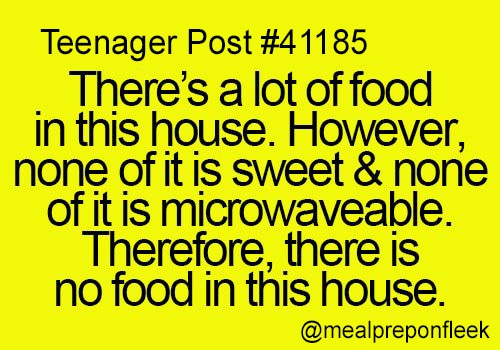How to Eat Healthy as a Teen (Plus a sample, full-day meal plan!)
Teenagers sometimes get a bad rap for not eating well; people often picture peanut butter and Nutella sandwiches, cans of soda, and (our favorite as a teen): black and white cookies from the vending machine at school.
However, that stereotype is just that—a stereotype. It’s not fact. While teenagers aren’t often equipped with the right knowledge to empower them to make the right food decisions, that doesn’t mean they’re not eager to learn.
As a teen growing into your own body, learning what foods you like, what foods feel good, and how to still get in a daily dessert, can be hard. It’s overwhelming to know the “right” way to do things—how many servings of fruits and veggies do we really need? And what about milk? Is pizza off-limits? This article will help wade through some of those questions and shed light on how to approach food choices.

But First—Why Do These Years Matter?
Since your body is still developing, good food choices during the teenage years really set yourself up for success later in life—whether it’s developing good eating habits, learning how to cook, or even preventing diseases like cancer and heart disease.
Moreover, according to EatRight.org, it’s recommended that teen boys get 2,200 to 3,200 calories a day (ages 14-18) and teen girls (also ages 14-18) get a daily 1,800 to 2,400 calories. However, that doesn’t mean these calories should come from bags of potato chips and candy bars. The types of calories that go into a teenagers’ body is critical since this is when you need essential nutrients—like iron and calcium—for bone growth and strength, and other important vitamins and minerals for metabolic and brain functions.
Plus, teenagers usually have a lot of energy. Your body needs this energy to grow and function; a helpful visual is to imagine your calories being a human battery needed to think and move around the day. You need healthy fats and carbohydrates so your body has the right types of calories to keep energy levels up without the notorious sugar crash while maintaining a healthy weight.
The Magic Combination
I’m sure we all wish that the healthy foods could also be the tasty ones. But they can be. The biggest barrier to get over is thinking that “healthy” only means steamed broccoli and tasteless chicken breasts. There’s a way to eat really well and enjoy it; you might even forget that fast food is a thing after you read the meal suggestions we provide towards the end of this article.
But first: here are some basic healthy food guidelines for teens. ChooseMyPlate.org, the government’s approved nutritional advice, recommends that teens should get their foods from these sources:
- Grains: Whole grains—like whole-wheat bread and brown rice—provide B vitamins, minerals, and fiber to help you feel fuller longer and concentrate better
- Vegetables: Veggies—peppers, mushrooms, tomatoes, onions—are chock full of so many vitamins and fiber essential for growth. (Put them on a veggie pizza!)
- Milk: Teenagers need the calcium, protein, and vitamin D in milk for strong bones, teeth, and muscles. Yes, low-fat chocolate milk counts here!
- Protein: Protein doesn’t necessarily mean a bacon cheeseburger. You can get protein and iron from a variety of foods, such as meat, poultry, fish, dry beans, peas, eggs, nuts, and seeds.
- Fruit: Chock full of Vitamin A, C, and fiber, it’s probably not hard to say yes to yummy fruits like pineapples, apples, and berries. Better yet, make a fruit smoothie with a cup of your favorite fruit, milk, and a tablespoon of peanut butter.
Here are some basic rules of thumb to follow, too:
-
- Try to limit added sugars
Yes, I know. Sweet tooths are hard to stave off. Still, it’s important to try and consume less than 10% of your daily calories from added sugars. A quick and easy way to do this is to avoid fruit juices (have a real piece of fruit instead!) and soda and to swap cookies and ice cream for dessert with a piece of dark chocolate. - Watch out for portion sizes
Oftentimes, our eyes are bigger than our stomachs. Watch out not for only what you eat, but how much of it you consume. By chewing slowly, you’ll let your hunger cues catch up with your taste buds, allowing your stomach to tell you you’re full when it’s really time to put the fork down. Also, avoid super-sizing anything. - Don’t skip meals!
- Try to limit added sugars
You might think that skipping a meal is a healthy option, especially if you want to lose some weight. This is false! Meal skipping will just slow down your metabolism, or lead you to order that super-sized meal come dinner time. Make sure to never skip breakfast, pack a healthy lunch at school, and enjoy dinner with your family. Kudos for helping in the kitchen, too!
Teen-Approved Meal Ideas
If you’re still wondering how to have a well-balanced meal that gives teens all the nutrients needed while still tasting darn good, look no further than this teen-approved day of food:
Breakfast:
-
-
- Two scrambled eggs with 1 cup of chopped zucchini and broccoli and one sausage link
- 1 cup of 1% milk
- Piece of fruit
-
Lunch:
-
-
- Hummus sandwich (2 tbsp) with a sprinkling of feta, sliced cucumbers, and sprouts on multigrain toast
- A handful of honey-roasted almonds
-
Snack:
-
-
- One piece of string cheese and a cup of grapes
-
Dinner:
-
-
- 3 oz grilled salmon with garlic sauce
- One mashed sweet potato
- Grilled asparagus (6-7 spears)
-
Dessert:
-
-
- ½ cup frozen yogurt with handful of cashews, pistachios, and dried figs
-
You can also find more teen-friendly recipes HERE.
[ajax_load_more post_type="post" sticky_posts="true" posts_per_page="3" category="blog" button_label="Keep Reading"]

Leave a Reply